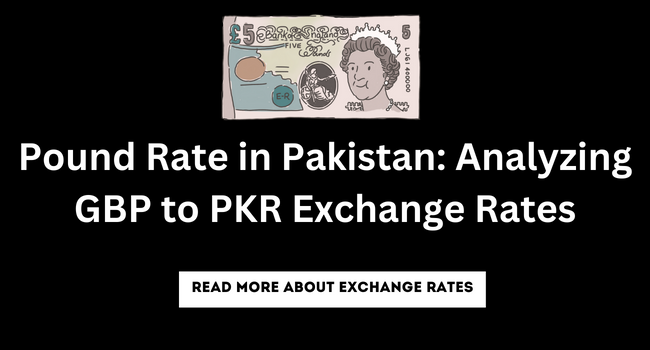The exchange rate between the British Pound (GBP) and the Pakistani Rupee (PKR) is a crucial economic indicator that affects trade, investment, and the overall economic well-being of both the United Kingdom and Pakistan. Understanding the factors that influence this exchange rate is essential for businesses, investors, and policymakers. In this article, we will delve into the dynamics of the GBP to PKR exchange rates, analyzing the factors that drive fluctuations and exploring the implications for various stakeholders.
Highlights
Understanding the GBP to PKR Exchange Rate
The exchange rate is simply the value of one currency in terms of another. In this context, the GBP to PKR exchange rate tells us how many Pakistani Rupees you need to exchange for one British Pound. Exchange rates are determined by a complex interplay of economic, political, and market forces. Let’s break down some of the key factors that influence the GBP to PKR exchange rate.
- Economic Indicators: One of the primary drivers of exchange rates is the relative economic health of the two countries. A strong UK economy, characterized by high GDP growth, low unemployment, and a stable financial sector, can lead to a stronger Pound. Conversely, a struggling economy can weaken the Pound. Similarly, the economic situation in Pakistan affects the Rupee’s value.
- Interest Rates: Central banks set interest rates to control inflation and stimulate or cool down economic activity. Higher interest rates in the UK can attract foreign capital, driving up demand for the Pound, and subsequently increasing its value against the PKR. Lower interest rates, on the other hand, can lead to a weaker Pound.
- Inflation Rates: Inflation erodes the purchasing power of a currency. A country with lower inflation rates generally sees an appreciation in the value of its currency. Therefore, differences in inflation rates between the UK and Pakistan can influence the GBP to PKR exchange rate.
- Political Stability: Political events can have a significant impact on exchange rates. Political instability, such as elections or changes in government, can cause uncertainty and lead to currency depreciation. On the other hand, a stable political environment can support a stronger currency.
- Trade Balance: A country’s trade balance, the difference between its exports and imports, can affect its currency’s value. A trade surplus (exports > imports) can increase demand for the home currency, strengthening it. Conversely, a trade deficit (imports > exports) can weaken the currency.
- Speculation: Traders and investors in the foreign exchange market often engage in speculative activities, which can lead to short-term fluctuations in exchange rates. News, market sentiment, and global events can drive speculative trading, impacting the GBP to PKR exchange rate.

Analyzing Historical Trends
To gain a better understanding of the GBP to PKR exchange rate dynamics, let’s analyze some historical trends. Over the past decade, this exchange rate has experienced significant fluctuations. In 2012, one British Pound was equivalent to approximately 132 Pakistani Rupees. However, by 2016, the Pound weakened significantly following the Brexit vote, and the exchange rate reached over 170 PKR per GBP.
After the initial shock of Brexit, the Pound gradually recovered, and by 2019, it was trading at around 200 PKR per GBP. Subsequently, in 2020 and 2021, the GBP to PKR exchange rate remained relatively stable, fluctuating between 210 and 220 PKR per GBP.
These historical trends highlight the influence of significant geopolitical events, such as Brexit, on exchange rates. They also illustrate how market sentiment, economic conditions, and political stability can cause substantial movements in the GBP to PKR exchange rate.
Impact on Various Stakeholders
The GBP to PKR exchange rate has far-reaching implications for a variety of stakeholders, both in the United Kingdom and Pakistan.
- Businesses: Companies engaged in international trade are particularly affected by exchange rate fluctuations. A strong Pound can make British goods more expensive for Pakistani consumers, potentially reducing exports. Conversely, a weaker Pound can make British products more competitive in Pakistan, boosting exports.
- Investors: Investors holding assets denominated in Pound Sterling are exposed to currency risk when investing in Pakistan. Exchange rate movements can significantly impact the value of their investments. Diversification and risk management strategies become crucial for investors in such scenarios.
- Tourists and Travelers: For UK tourists traveling to Pakistan, a stronger Pound means they get more Rupees for their money, making travel more affordable. Conversely, a weaker Pound can make travel to Pakistan relatively more expensive.
- Governments and Central Banks: Policymakers in both countries closely monitor exchange rates. Central banks may intervene in currency markets to stabilize or influence their currency’s value. Governments also consider exchange rates when implementing trade policies and tariffs.
- Expatriates: Pakistani expatriates living and working in the UK often send remittances back to Pakistan. Exchange rate movements can affect the amount of money their families receive, impacting their standard of living.
Conclusion
The GBP to PKR exchange rate is a critical economic indicator that reflects the economic health, political stability, and market dynamics of both the United Kingdom and Pakistan. Understanding the factors that influence this exchange rate is essential for businesses, investors, and policymakers. Historical trends and recent events, such as Brexit, demonstrate the significant impact that external events and market sentiment can have on the GBP to PKR exchange rate.
Stakeholders, including businesses, investors, tourists, governments, and expatriates, need to monitor and manage their exposure to exchange rate risk. Diversification, risk management strategies, and staying informed about economic and political developments in both countries are essential for mitigating the potential impact of currency fluctuations.
As the global economy continues to evolve, the GBP to PKR exchange rate will remain a dynamic and ever-changing metric that reflects the complex interplay of economic and geopolitical forces. Staying informed and adaptable is key for those who are impacted by this exchange rate, whether directly or indirectly. Click here to learn more





Leave a Reply